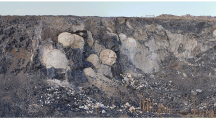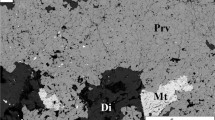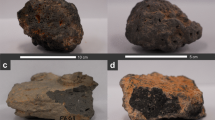Abstract
The morphology and internal structure of individual olivine grains from ultramafic rocks in the Guli and Gal’moenan dunite massifs differing in origin are considered. To restore the ontogeny of mineral aggregates, traces of elastic deformation retained in mineral grains have been used. Comparison of anatomy of olivine grains from these two massifs showed that the mechanism of accommodation of rocks to changing geological settings is expressed as the response of the mineral aggregate structure and variation in the anatomy of individual mineral grains. At the level of individual grains, this is annihilation of older defects and origination of younger dislocations; refinement of the crystal lattice; exsolution; formation and transformation of new mineral phases; and creep and migration of subboundaries within grains. At the aggregate level, this is rotation and migration creep of the internal boundaries of rock; formation of new boundaries of mineral intergrowths; reorientation of boundaries; and variation in their extent, density, and grain dimensions. The prehistory of massifs controls the manifestation and abundance of various elastic deformations and related types of recrystallization of olivine grain boundaries and subboundaries in aggregates. New conditions and accommodation of mineral aggregates to these conditions have instigated specific schemes of recrystallization, which bear information on the history of rocks and their massifs.
Similar content being viewed by others
References
S. Arai, “Chromian Spinel Lamellae in Olivine from the Iwanai-Dake Peridotite Mass, Hokkaido, Japan,” Earth Planet. Sci. Lett., No. 39, 267–273 (1978).
L. G. Berry, B. H. Mason, and R. V. Dietrich, Mineralogy (Freeman, San Francisco, 1983; Mir, Moscow, 1987) [in Russian].
A. G. Betekhtin, Course of Mineralogy (Gosgeoltekhizdat, Moscow, 1961) [in Russian].
G. B. Bokii, Crystal Chemistry (Nauka, Moscow, 1971) [in Russian].
R. L. Brodskaya, I. V. Bilskaya, V. Lyakhnitskaya, et al., “Boundaries of Intergrowths between Mineral Individuals: A Zone of Secondary Mineral Formation in Aggregates,” Zap. Ross. Mineral. O-va 136(3), 1–18 (2007) [Geol. Ore Deposits 49 (Spec. Issue 8, Zapiski Russian Mineral. Soc.), 669–680 (2007)].
A. I. Goncharenko, Deformation and Petrostructural Evolution of Alpine-Type Ultramaphic Rocks (Tomsk State Univ., Tomsk, 1989) [in Russian].
A. I. Goncharenko and A. I. Chernyshev, Deformational Structure and Petrology of Nephrite-Bearing Ultramafic Rocks (Tomsk State Univ., Tomsk, 1990) [in Russian].
F. P. Lesnov, A. I. Chernyshev, and V. E. Istomin, “Geochemical Characteristics and Typomorphism of Olivine from Heterogeneous Ultramafic Rocks,” Geokhimiya, 43(4), 395–414 (2005) [Geochem. Int. 43 (4), 354–371 (2005)].
A. A. Melyakhovetsky, Metamorphism of Ultramafic Rocks in Eastern Tuva (Nauka, Novosibisrk, 1982) [in Russian].
J.-C. C. Mercier and A. Nicolas, “Textures and Fabrics of Upper-Mantle Peridotites As Illustrated by Xenoliths from Basalts,” J. Petrol. 16(2), 454–487 (1975).
A. Nicolas, F. Boudier, and A. M. Boullier, “Mechanisms of Flow in Naturally and Experimentally Deformed Peridotites,” Am. J. Sci. 273(10), 653–876 (1973).
J.-P. Poirier, Creep of Crystals (Cambridge Univ. Press, Cambridge, 1986; Mir, Moscow, 1988).
R. Y. Zhang, J. F. Shu, H. K. Mao, and J. G. Liou, “Magnetite Lamellae in Olivine and Clinohumite from Dabie UHP Ultramafic Rocks, Central China,” Am. Mineral. 84, 564–569 (1999).
S. A. Shcherbakov, “Mechanism of Ductile Deformation of Ultramafic Rocks in the Voikar-Syn’ya Massif, the Polar Urals,” Geotektonika 15(4), 44–56 (1981).
S. A. Shcherbakov, “Ductile Deformation of Ultramafic Rocks in Ophiolite Association of the Urals (Nauka, Moscow, 1990) in Russian].
V. R. Shmelev, Ultramafic Rocks of the Syum-Keu Massif, The Polar Urals: Structure, Petrology, and Metamorphism (Ural Division, UssR Acad. Sci., Yekaterinburg, 1991) [in Russian].
E. G. Sidorov, A. P. Kozlov, E. A. Landa, et al., “Petrogeochemical Features of Rocks from the Gal’moenan Mafic-Ultramafic Massif, Koryakia,” in Petrology and Metallogeny of Mafic-Ultramafic Complexes in Kamchatka (Nauchnyi Mir, Moscow, 2001), pp. 14–30 [in Russian].
J. R. Smyth, S. D. Jacobsen, and R. M. Hazen, “Comparative Crystal Chemistry of Orthosilicate Minerals,” Rev. Mineral. Geochem. 41, 157–209 (2000).
Author information
Authors and Affiliations
Corresponding author
Additional information
Original Russian Text © R.L. Brodskaya, I.V. Bilskaya, B.A. Markovsky, 2009, published in Zapiski RMO (Proceedings of the Russian Mineralogical Society), 2009, No. 5, pp. 19–31.
Rights and permissions
About this article
Cite this article
Brodskaya, R.L., Bilskaya, I.V. & Markovsky, B.A. Ontogenetic analysis of individual olivine grains in ultramafic rocks. Geol. Ore Deposits 52, 566–573 (2010). https://doi.org/10.1134/S1075701510070056
Received:
Published:
Issue Date:
DOI: https://doi.org/10.1134/S1075701510070056




